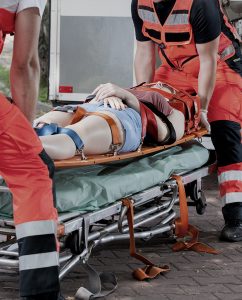Brain Injury
A traumatic injury to the brain, also known as a TBI, occurs when a sudden trauma, such as a severe blow or jolt to the head, disrupts normal function of the brain and causes brain damage. Evidence of a brain injury can surface through various symptoms including severe headache, seizures, nausea and vomiting, weakness in extremities, dizziness, loss of coordination and/or consciousness, and personality change. The consequences of a brain injury can be dire, as these injuries may result in vegetative states, coma, and even brain death for those affected by the head trauma. This type of injury carries a strong potential for long-term debilitation and a profound change in lifestyle. Some brain injuries are less severe; the symptoms are subtle and an experienced attorney is needed to properly prove the injuries.

Accidents involving motor vehicles, pedestrians, and bicycles account for half of all brain injuries for those under the age of 65, and about 40% of all spinal cord injuries.
Spinal Cord Injuries
Spinal cord injuries, like TBIs, can arise from a physically traumatic event, such as a motor vehicle accident, or they may develop as a result of a disease like polio. Injuries to the bundles of nerves within the spinal column result in a loss of mobility and sensation throughout specific areas of the body. Spinal cord injuries can be categorized as either complete or incomplete, depending upon the amount of mobility and functioning that is lost after the injury.
A person with a complete injury has no feeling or functioning ability below the site of the trauma on either side of his or her body, whereas an incomplete injury allows some function and sensation below the trauma location. Along with impaired motor function, spinal injuries can also trigger bowel and bladder problems, sexual dysfunction, and chronic pain. In extreme cases, involuntary movement, such as breathing, requires machine assistance, because the injured person cannot perform this basic function on his or her own.
Motor Vehicle Accidents

Accidents involving motor vehicles, pedestrians, and bicycles account for half of all brain injuries for those under the age of 65, and about 40% of all spinal cord injuries. Falls are the second highest cause of traumatic brain injury and spinal cord injury, especially for those over the age of 65.
Contact Us for Help
The experienced lawyers at Liss & Marion can review your case as part of a free consultation to determine how we can help you. Contact Liss & Marion for a free consultation about your legal options.

